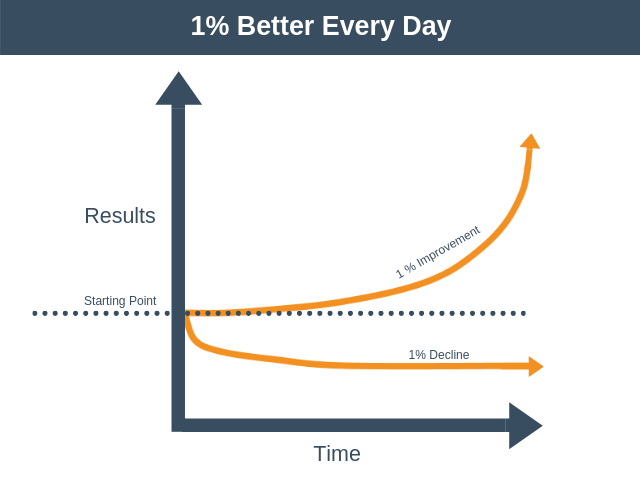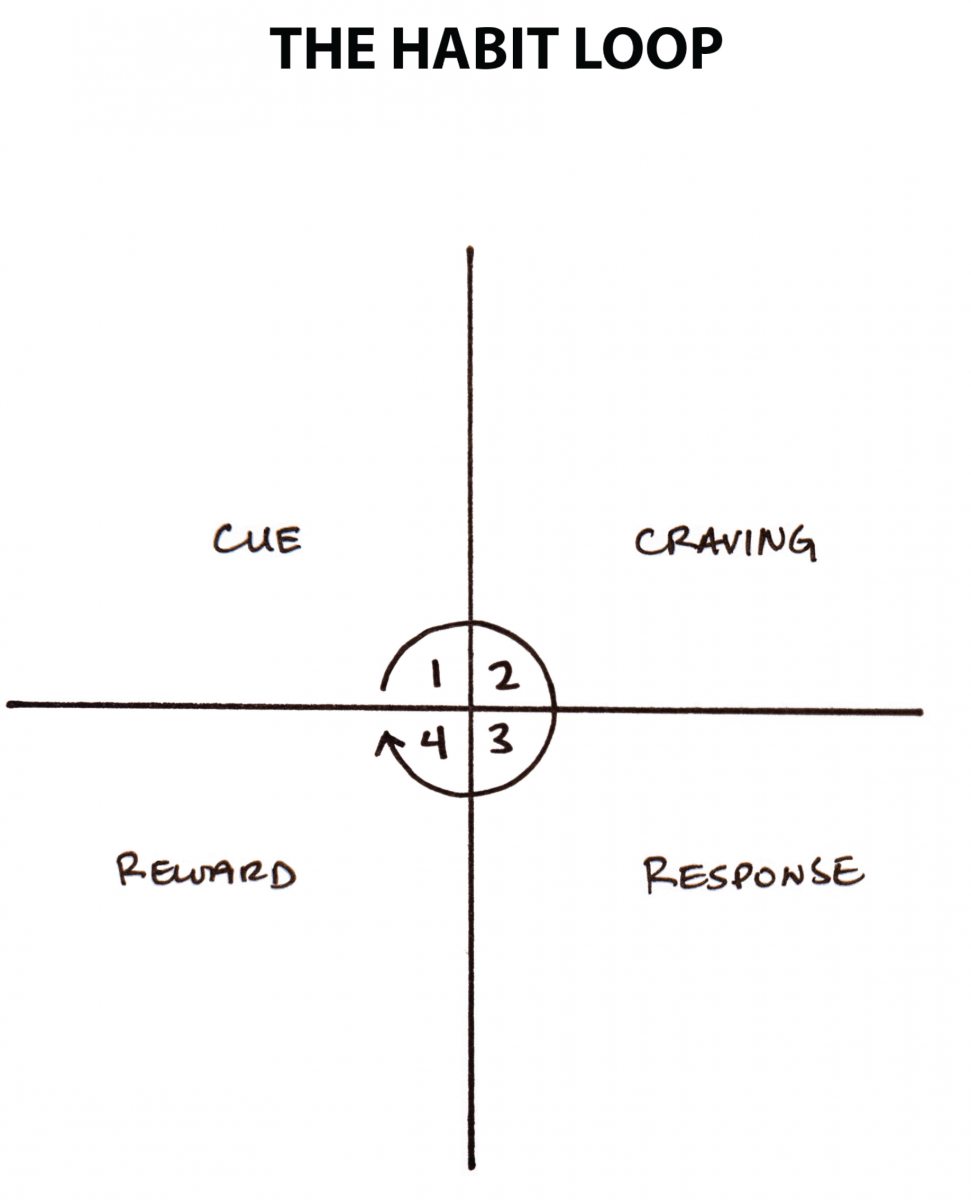
Title: Atomic Habits
Author: James Clear
Publisher: Penguin Random House
ISBN-10: 1847941834
ISBN-13: 978-1847941831
Buy from: Amazon.in | Amazon.com
Introduction
There is a myth and an all-pervading belief that in order to transform your life, we need to transform our behaviour in a major way and need to do is fast. To lose weight, people go on crash diets overnight. Alcoholics and addicts go cold turkey. People with no previous experience with workouts join the gym and work out so hard on day 1 that they get sore muscles.
James Clear offers us a better solution in his book Atomic Habits. He argues that in order to transform our life and add new behaviour, it is necessary to take tiny steps and let the habits build and then change one thing at a time.
The 1% rule

James Clear talks about how the 1% rule, the commitment to improve every aspect of our performance by 1% every day, changed the fate of British bicycling. From being a mediocre group of pedallers, the British went on to become champions in both the Tour de France and Olympics in 2012, which they hosted. They didn’t do anything drastic to get there. All they did was find tiny areas to improve every day, from how to align their wheels in the most stable way right down to how to get better sleep every night.
Tiny improvements compound over time and the 1% that you change for the better everyday soon becomes a massive number. Nothing seems to happen initially as the changes are tiny. But out of the blue, things seem to change overnight. This is similar to the way you melt ice on a stove. No amount of heat seems to melt the ice when it is at -5 degrees Celsius. But the temperature of the ice keeps increasing: -4.9, -4.8 and so on. At 0 degrees Celsius, you begin to see the water droplets on the molten surface. Suddenly, the ice melts rapidly right in front of you. But it is not just the heat supplied at the 0 degree point that was responsible for the ice melting. It is also all the heat that raised the temperature of the ice by insignificant tenths of a degree.
Set goals, but work on systems
While goals are good to give you a direction to work on, e.g. “I want to reduce to 65 kg”, you should think systems on a day-to-day basis. On a daily basis, you should work on actions such as, “1 hour of cardio, 30 minutes of strength training, 100 grams of proteins everyday, no refined carbs”. Once a system is set, you should ignore the goal that says that you want to change your weight. Lifestyle design works better than working for a goal, because they are based on habits, something that works its way into your day-to-day life and you no longer have to think about it.
Moreover, your goal is achieved when you reach 65 kg. What happens when you get there? You need to maintain yourself at 65 kg. The goal is gone and so is the motivation that came with working for it. But a system of habits that you set up for yourself will ensure that you live the healthy lifestyle everyday and that’s what keeps you at 65 kg.
The power of identity
Identities are a powerful way to shape your habits. If you were to set an identity for yourself that says, “I am an athelete. This is what athletes do. And this is what athletes don’t do”, then you have a standard to live up to. You will successfully show up at the gym, eat healthier, stop smoking and drinking and stop cribbing about hard work.
Every time you are faced with a choice of doing something hard, but healthy, your identity will prompt you, “True athletes don’t sleep in. They wake up and show up for an early morning workout. So I should do it too.” And every time you are faced with a gratifying temptation, your mind says, “True athletes don’t eat two pastries a night. They take care of their carb intake. I should do it too.”
The phases of habits
Every habit has four phases.

- Cue: An event that reminds you to start your habit. E.g. a little peckishness in your stomach to remind you that you are hungry.
- Craving: A feeling that urges you to take an action. The hunger induces a craving for tasty food. Your tongue anticipates the taste and starts salivating.
- Action: An action you take to fulfill the craving and claim a reward. You consume food.
- Reward: The craving goes away and you feel good, really good. It’s a feeling worth taking the above action for. E.g., while eating food, your taste buds gets a burst of flavours. After your meal, your hunger is sated.
It is human nature to take the shortest path to a reward. If your office has a vending machine just around the corner and a cafetaria on a different floor, then you will take a packet of chips from the vending machine before your realise it. However if you further shorten the path to the reward, say by having a packet of nuts and dry fruits in your desk drawer, guess what you will reach for!
Habit change
To change an undesired habit, based on its four phases, here are some techniques.
- Remove the cue: For some habits such as alcoholism, the mere sight of a bottle of whisky can trigger a craving. So removing the cue eliminates the craving. For other things such as hunger, the cue is natural and cannot be simply removed.
- Make the right action easy: If your fridge is stocked with cola, then you will reach for one when you are thirsty on a warm day. Instead, put cola out of reach and stock your fridge with chilled water. The right behaviour is now automatic.
- Ensure similar rewards: There is a reason why people give up on kale juice and go back to cola when they are thirsty. Kale juice tastes terrible. When you want to change a habit, you are looking for similar rewards, otherwise the motivation for the altered behaviour is lost. If you want to replace cola with kale juice, start with juice from a citrus fruit such as orange and add the pulp from two kale leaves in it. Gradually increase the amount of kale and decrease the fruit juice. As you acquire the taste for kale, you can start eliminating the citrus juice slowly. One day, out of sheer habit and acquired taste, the taste of kale will act as the reward and cola will no longer seem satisfying.
Tracking your habits
Keeping a score of your habits can keep your motivation high as you see the streak of the number of days you have persisted with it. Habit scorecards also help you determine which habits are benefitting you and which ones you would no longer like to keep.
Habit stacking
You can use an existing habit as a cue to a new habit. E.g. your return from gym can act as the cue to prepare and eat a protein rich breakfast. The end of your reading session can act as a cue for a new habit in which you would like to take notes about what you read.
When a habit is already deeply rooted, it can act as the trigger for any new habit that you desire.
Will power is over-rated, your environment controls you
We like to think that we are in control of our lives, but our behaviour is altered by the smallest of cues from our surroundings. You will drink more if you are with friends who consider it cool to get drunk at parties. You will eat more if your spouse eats more. Your children will watch more TV if you do it too.
Brute-forcing your way through a habit using sheer will power is not sustainable. If you want to work out early in the morning, then enroll for a gym that is within a kilometre from your home. If you want to eat healthy, then remove all the junk food from your home.
Make the habit and the rewards pleasurable
In order to continue a habit, it needs to appeal to you. Start by setting rewards that you would love as a result of the habit. If you make your health food tasty, then you are more likely to stick to it. If your treadmill plays a documentary from National Geographic every time you use it then you are likely to keep using it.
Next, make the habit itself pleasurable. What if kitchen time is when you and your spouse have conversations? What if instead of monotonously working out on a stationary bicycle, you take a real bicycle to the woods around your neighbourhood.
The above are examples of temptation bundling, which is a method of unlocking pleasurable experiences if you were to stick to your habits. The habits themselves or their rewards will become worth waiting for and doing.
Conclusion
The above are just some key points from this really useful book on building habits and behaviour change. If you are looking to transform your life in a major way, do not bring major changes immediately. Instead think of tiny, atomic changes that you can bring to your life everyday that compound themselves and lead to the major change.

We know you love books. We would you like to give two FREE audio books. Grab your trial Audible Membership with Two Free Audio Books . Cancel at anytime and retain your books.
The Japanese call these continuous improvement as ‘Kaizen’. The book indeed talks about great ways to bring kaizen into our everyday lives. Half the success indeed is in showing up i.e consistency.